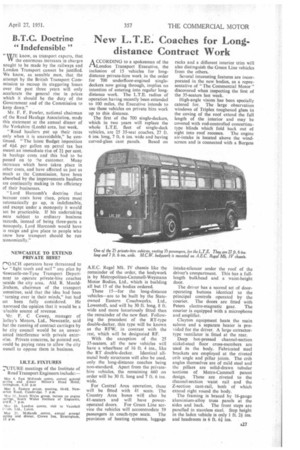New L.T.E. Coaches for Long distance Contract Work
Page 29

If you've noticed an error in this article please click here to report it so we can fix it.
A CCORDING to a spokesman of the 1–ILondon Transport Executive, the inclusion of 15 vehicles for longdistance private-hire work in the order for 700 underfloor-engined singledeckers now going through, implies no intention of entering into regular longdistance work. The L.T.E. radius of operation having recently been extended to 100 miles, the Executive intends to use these vehicles on private hire work up to this distance.
The first of the 700 single-deckers, which in two years will replace the whole L.T.E. fleet of single-deck vehicles, are 25 35-seat coaches, 27 ft. 6 ins. long, 7 ft. 6 ins, wide and having curved-glass cant panels. Based on A.E.C. Regal Mk. IV chassis like the remainder of the order, the bodywork is by Metropolitan-Cammell-Weymann Motor Bodies, Ltd., which is building all but 15 of the bodies ordered.
These 15—for the long-distance vehicles—are to be built by the Stateowned Eastern Coachworks, Ltd., Lowestoft, and will he 30 ft long, 8 ft. wide and more luxuriously fitted than the remainder of the new fleet. Following the precedent of the RT-type double-decker, this type will be known as the RFW, in contrast with the rest, which will be designated RF.
With the exception of the 25 35-seaters, all the new vehicles will have a wheelbase of 16 ft. 4 ins., like
the RT double-decker. Identical allmetal body structures will also be used, only the long-distance coaches being non-standard. Apart from the privatehire vehicles, the remaining 660 on order will be 30 ft. long and 7 ft. 6 ins. wide.
For Central Area operation, these will be fitted with 41 scats. The Country Area buses will also be 4I-seaters and will have poweroperated doors. For Green Line service the vehicles will accommodate 39 passengers in coach-type seats. The provision of heating systems, luggage racks and a different interior trim will also distinguish the Green Line vehicles from the others.
Several interesting features are incorporated in the new bodies, as a representative of "The Commercial Motor" discovered when inspecting the first of the 35-seaters last week.
High-angle vision has been specially catered for. The large observation windows of Triplex toughened glass in the coving of the roof extend the full length of the interior and may be covered with rod-controlled concertinatype blinds which fold back out of sight into roof recesses. The engine air-intake is located above the windscreen and is connected with a Burgess intake-silencer under the roof of the driver's compartment. This has a fulllength bulkhead and a waist-height door.
The driver has a second set of dooroperating buttons identical to the principal controls operated by the courier. The doors are fitted with Peters electro-magnetic gear. The courier is equipped with a microphone and amplifier.
Clayton equipment heats the main saloon and a separate heater is provided for the driver. A large extractortype ventilator is fitted at the rear.
Deep hot-pressed channel-section nickel-steel floor cross-members are used in the body. Fabricated steel brackets are employed at the riveted crib angle and pillar joints. The crib angles themselves are of mild steel and the pillars are solid-drawn tubular sections of. Metro-Cammell patent design. These are riveted to the channel-section waist rail and the Z-section cant-rail, both of which extend right round the body.
The framing is braced by 16-gauge aluminium-alloy truss panels at the sides and back. The front steps are panelled in stainless steel. Step height in the laden vehicle is only 1 ft. 21 ins, and headroom is 6 ft.. 6i ins.












































































